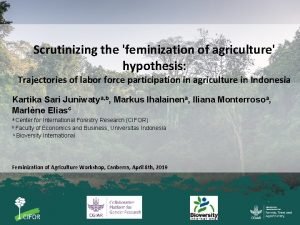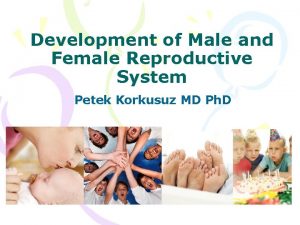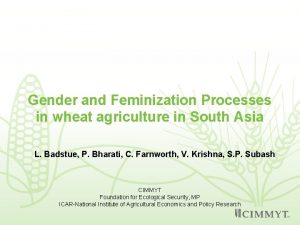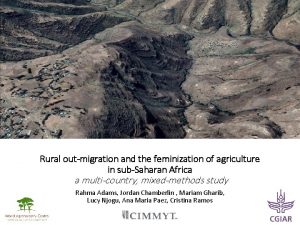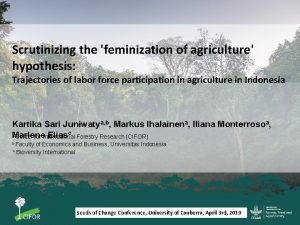Exploring feminization of agriculture through gender dynamics across








- Slides: 8

Exploring feminization of agriculture through gender dynamics across scales Alessandra Galiè 1, Stephen Oloo 1, Catherine Pfeifer 2 1 International Livestock Research Institute (ILRI) 2 Research Institute of Organic Agriculture (Fi. BL) Writeshop at KIT, November 2019

This study in a nutshell Methodological inter-disciplinary study to understand how gender dynamics at household and community level influence Feminization of Agriculture (Fo. A) Research question: How do intra-household gender dynamics scale to shape the regional/global trend ‘Fo. A’?

What we do in this study • Develop a methodology to study how gender dynamics at hh and community level scale to influence Fo. A. • Pilot methodology with existing datasets on Fo. A in selected countries of sub-Saharan Africa (focus on livestock) and qual findings. • Validate/challenge persistent assumptions about Fo. A.

How we do it: 6 main steps 1. Develop a conceptual framework on drivers affecting Fo. A 2. Identify key drivers and dynamics behind Fo. A 3. Use existing DHS national-level data to identify countries with Fo. A or Mo. A 4. Use DHS, WB and SIGI to analyse how 3 drivers interact to form clusters of countries 5. Use existing data sets at hh level (i. e. DHS) to identify interaction among drivers in the countries identified 6. Identify patterns of interactions 7. Conducts qualitative fieldwork to explore how gender dynamics have played out in reality 8. Adjust the drivers and model 9. Possibly: adapt ‘model’ for exploring future emerging social landscapes in agriculture

Key findings: 3 drivers identified Individual and household level Institutions (policies and gender norms) Individual capabilities Hh, community, national levels Market opportunities Local, national, global levels

Key Findings cont… • Identified 6 clusters of countries with similar patterns: Cluster 1 : Uganda Cluster 2 : Congo-Brazaville Cluster 3 : Kenya, Liberia, Rwanda, Tanzania Cluster 4 : Burundi, Benin, Lesotho, Nigeria Cluster 5 : Democratic Congo, Namibia, Zimbabwe, Zambia Cluster 6 : Egypt, Ghana, Sierra Leone Overall: Only in Ug: Fo. A; Proportion of women in ag is decreasing (Y 2 -Y 1) in 3 clusters and increasing in 3 clusters. The proportion of men in ag (Y 2 -Y 1) is increasing in all clusters. First 5 clusters show a move from agriculture to nonagriculture, these are also the countries with economic growth. There is a return to agriculture (mostly by men but also some women) in cluster 6 - countries which show economic recession.

Questions and concerns Our aim is to scale gender dynamics (not genderdisaggregated data). Are we getting there? Is qual the best approach? Or how can we scale unpredictable, gendered, human behaviour?

better lives through livestock ilri. org The presentation has a Creative Commons licence. You are free to re-use or distribute this work, provided credit is given to ILRI.


